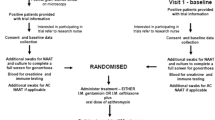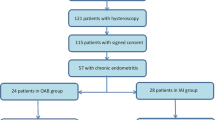Summary
Forty-six females with pelvic soft tissue infections (recurrent salpingitis [n=14], salpingitis with intrauterine contraceptive device [IUD] [n=9], salpingitis with adnexal mass [n=14], post-partum endomyoparametritis [n=9]) were randomized for three antibiotic treatment regimens: cefotaxime (CTX) (n=23), clindamycin and gentamicin (C+Gen) (n=13), and clindamycin, gentamicin and penicillin (C+Gen+P) (n=10). Patients were evaluated by diagnosis for clinical response to the three regimens and by pre-treatment bacterial susceptibility to the individual as well as the combination antibiotics. All 14 recurrent salpingitis patients responded satisfactorily to the assigned antibiotic regimen (CTX, n=8; C+Gen, n=3; C+Gen+P, n=3). One of four patients with the diagnosis of salpingitis/IUD treated with CTX was a treatment failure, while three of three patients treated with C+Gen and two of two patients with C+Gen+P responded satisfactorily. Two of three patients with the diagnosis of salpingitis/adnexal mass failed therapy with C+Gen while the seven patients treated with CTX and the four patients with C+Gen+P responded satisfactorily. All nine patients with endomyoparametritis responded to their treatment regimen. Overall, there were no statistically significant differences in the responses by diagnosis and regimen, with the exception that C+Gen was significantly different (p<0.05) from CTX and C+Gen+P for the treatment of salpingitis with mass. Of the 141 bacterial isolates in all groups, 57 were aerobic or anaerobic gram-positive organisms. Of these 57 isolates, seven (12.3%) were resistant byin vitro testing to cefotaxime, 11 (19.3%) to clindamycin, three (5.3%) to penicillin and 20 of 34 (58.8%) to gentamicin.Chlamydia trachomatis was isolated from a single patient,Mycoplasma hominis from 16 patients andUreaplasma urealyticum from 14 patients. The results of our study indicate that the cefotaxime regimen was as effective as the combination regimens in the treatment of female soft tissue infection.
Zusammenfassung
46 Frauen mit Adnexitis (rezidivierende Salpingitis in 16, Salpingitis bei Intrauterinpessar in neun, Salpingitis mit Adnextumor in 14 und postpartale Endomyoparametritis in neun Fällen) erhielten nach Randomverfahren entweder Cefotaxim (CTX; n=23), Clindamycin plus Gentamicin (C+Gen; n=13) oder Clindamycin plus Gentamicin plus Penicillin (C+Gen+P; n=10). Die Patientinnen wurden nach Diagnosegruppen auf den klinischen Therapie-Erfolg hin untersucht; die Empfindlichkeit der isolierten Erreger gegen die genannten Antibiotika wurde jeweils gegenüber den Einzelsubstanzen und Kombinationen geprüft. Alle Frauen mit rezidivierender Salpingitis sprachen zufriedenstellend auf die zugeteilte Antibiotika-Therapie an (CTX, n=8; C+Gen, n=3; C+Gen+P, n=3). Eine von vier Patientinnen, mit der Diagnose Salpingitis bei Intrauterinpessar, die mit CTX behandelt wurde, sprach nicht auf die Therapie an. Bei drei von drei mit C+Gen und zwei von zwei mit C+Gen+P behandelten Frauen wurde ein Therapie-Erfolg erzielt. Zwei von drei Patientinnen mit der Diagnose Salpingitis mit Adnextumor sprachen nicht auf C+Gen an, bei sieben mit CTX und vier mit C+Gen+P behandelten Frauen war die Therapie gut wirksam. Bei allen Patientinnen mit Endomyoparametritis war die Therapie erfolgreich (CTX, n=4; C+Gen, n=4; C+Gen+P, n=1). Bezogen auf Diagnosen und Therapiegruppen waren in der klinischen Erfolgsrate keine signifikanten Unterschiede zu erkennen mit Ausnahme von C+Gen gegenüber CTX und C+Gen+P bei Salpingitis mit Adnextumor (p<0,05). Von 141 isolierten Bakterien aus der Gesamtgruppe waren 57 aerobe oder anaerobe grampositive Keime. Davon warenin vitro 7 (12,3%) gegen Cefotaxim, 11 (19,3%) gegen Clindamycin, 3 (5,3%) gegen Penicillin und 20/34 (58,8%) gegen Gentamicin resistent. Von einer Patientin wurdeChlamydia trachomatis, von 16Mycoplasma hominis und von 14Ureaplasma urealyticum isoliert. Die Ergebnisse zeigen, daß Cefotaxim in der Therapie von Infektionen der Organe des kleinen Beckens bei der Frau ebenso wirksam war wie die Kombinationsschemata.
Similar content being viewed by others
Literature
Eschenbach, D. Diagnosis and treatment of salpingo-oophoritis. In:Ledger, W. J. (ed.): Antibiotics in obstetrics and gynecology. Martinus Nijhoff, Boston 1982, pp. 101–117.
Hemsell, D. L., Cunningham, F. G., Nolan, C. M., Miller, T. T. Clinical experience with cefotaxime in obstetric and gynecologic infections. Rev. Infect. Dis. 4 Suppl. (1982) 432–438.
Schacter, J. Chlamydiae psittacosis-lymphogranuloma venereum trachoma group. In:Lennette, E. H., Balows, A., Hausler, W. J., Jr., Truant, J. P. (eds.): Manual of clinical microbiology. American Society of Microbiology, Washington, D.C. 1980, pp. 357–364.
Braun, P., Klein, J. O., Lee, Y. H., Kass, E. H. Methodologic investigations and prevalence of genital mycoplasmas in pregnancy. J. Infect. Dis. 121 (1970) 391–400.
Bartlett, J. G., Polk, F. B. Bacterial flora of the vagina: Quantitative study. Rev. Infect. Dis. 6 Suppl. 1 (1984) 67–72.
Eschenbach, D. A. Epidemiology and diagnosis of acute pelvic inflammatory disease. Obstet. Gynecol. 55 Suppl. (1980) 142–153.
Centers for Disease Control Sexually transmitted diseases treatment guidelines, 1982. MMWR 31 Suppl. (1982) 33–60.
Author information
Authors and Affiliations
Rights and permissions
About this article
Cite this article
Roy, S., Wilkins, J. Cefotaxime in the treatment of female pelvic soft tissue infections. Infection 13 (Suppl 1), S56–S61 (1985). https://doi.org/10.1007/BF01644220
Issue Date:
DOI: https://doi.org/10.1007/BF01644220




